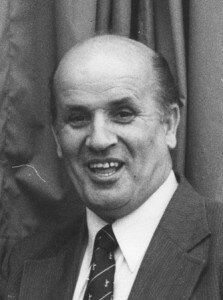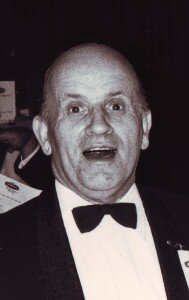George Wallace, 5 August 1926–11 January 2011.
Roy Hay
George Wallace served in the British army in the 1940s and again in the 1960s rising to become chief clerk to the Chief of Staff of the defence forces during the latter period. On his first encounter with Australia, he accompanied Denis Healey, the Minister of Defence, to Canberra on behalf the United Kingdom government. As a senior non-commissioned officer in his forties in 1969 he was faced with being commissioned and starting again at the bottom as a Lieutenant or remaining as an NCO. One of his sons had already emigrated to Australia, staying with an aunt in Dandenong, so George decided to give this country a try in 1970.
While in services he had played football but found very soon that his talents lay elsewhere and he became a referee where his discipline and a stentorian voice quickly helped him establish control. He took courses in refereeing and inspecting at Loughborough College and rose to the top of his other profession, refereeing international matches in Nigeria and becoming secretary of the refereeing bodies of which he was a member. So he was a highly experienced administrator with a deep knowledge of the game when he arrived in Victoria and, after working with Nylex, within a year was appointed Secretary of the Victorian Soccer Federation in 1971. He remained as secretary and later Chief Executive Officer of the VSF until 1991.
He very quickly put his stamp on the Federation working with a series of Presidents to develop the game in Victoria and Australia. Sir David Hill-Wood, of the famous Arsenal family, Commander Michael Parker, former equerry to the Queen, were succeeded by Theo Marmaras and John Dimtsis, while Michael Weinstein was chairman of the Federation from 1973 to 1986. George Wallace remembers receiving some excellent advice from his chairman. ‘George, You will succeed if you remember the power base of the Federation’. He knew how to bring about the results he wanted.
In many ways George Wallace was ahead of his time. He wanted professional referees in the 1970s. He fought to reduce the unwieldy club-dominated Board and State League Management Committees to smaller more efficient bodies. He was very conscious of the fragmented nature of the game outside the metropolitan area with a few excellent centres including Bendigo and Latrobe Valley and others which were barely functional. Knowing the dominant position of the Victorian, later the Australian Football League, he thought that Association football in Victoria had to put its house in order if it was to have any chance of establishing the profile the game deserved and required. In particular it needed to have a commission of independent persons to oversee the development of the code as the AFL was doing in the early 1990s.
He became President of the Federation in 1994 and remained in office for a decade. From 1997 to 1999 Jeff Kennett served as Honorary Executive President, but it was George who did the hard work behind the scenes to keep the Federation going. He was not happy as a public speaker or as the mouthpiece of the Federation, preferring to let his deeds rather than his words speak for him. He had broad shoulders and could take and deflect a lot of the criticism which came his way, but his monument is that he held the disparate interests of the game together during a period of considerable change. He had a ferocious honesty and sense of fair play and would not countenance anything which was not done with defensible due process. He did what he believed he had to do in the interests of the game even though this sometimes ruffled delicate feathers.
He was a Life Member of the VSF and Football Federation Victoria and a member of the Australian Football Hall of Fame, Roll of Honour. If you click on his name on his Wikipedia entry it takes you to the controversial former governor of Alabama and United States presidential candidate, something which would have amused George very much.
He is survived by his sons, Ian and Michael, grandchildren Scott, Holly, Laura, Jamie and Rachel and great-grandchildren, Hunter and Amelia.









Marnie Haig-Muir: Your review of the latest Rankin is right on the money, Roy. This book...